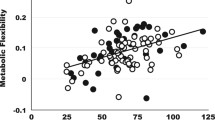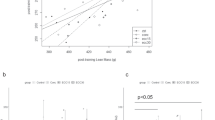Summary
Adipose tissue lipolytic activity is increased in endurance-trained subjects, but little is known about the mechanisms of this increase. To understand more fully the mechanisms involved and to discover whether sex-related differences exist, biopsies of fat were performed in the periumbilical region of 20 sedentary subjects (10 women (W) and 10 men (M)) and 20 trained subjects (10 W, 10 M); the in vitro response to epinephrine of the collagenase-isolated fat cells was studied. Glycerol release, chosen as an adipocyte lipolysis indicator, was measured by bioluminescence. Dose-response curves with epinephrine (α2 and β agonist), with isoproterenol (β agonist) and epinephrine + propranolol and adenosine deaminase, were studied. Epinephrine-induced lipolysis was enhanced in trained subjects and this was due to an increased efficiency of the β-adrenergic pathway. However, differences were found between the two sexes. In trained men, the lipolysis increase resulted from the enhancement of the β-adrenergic pathway efficiency without any significant decrease in the α2-adrenergic pathway efficiency. In trained women, the lipolysis increase was not only due to the enhancement of the β-adrenergic pathway efficiency (which was greater than in trained men), but also to a significant decrease in the α2-adrenergic pathway efficiency. Despite the decrease, the α2-adrenergic pathway remained more efficient in trained women than in trained men, as was the case in sedentary subjects. It is concluded that endurance training led to better lipid mobilization and that this effect seemed greater in women than in men.
Similar content being viewed by others
References
Ahlborg B, Bergstrom J, Ekelund LG, Hultman E (1967) Muscle glycogen and muscle electrolytes during prolonged physical exercise. Acta Physiol Scand 70:129–142
Arner P, Ostman J (1974) Mono- and diacylglycerols in human adipose tissue. Biochim Biophys Acta 369:209–221
Arner P, Arner O, Ostman J (1973) The effect of local anesthetic agents on lipolysis by human adipose tissue. Life Sci 13:161–169
Askew EW, Hecker AL (1976) Adipose tissue cell size and lipolysis in the rat: response to exercise intensity and food restriction. J Nutr 106:1351–1360
Askew EW, Huston RL, Plopper CG, Hecker AL (1975) Adipose tissue cellularity and lipolysis. Response to exercise and cortisol treatment. J Clin Invest 56:521–529
Bjorntorp P, Ostman J (1971) Human adipose tissue dynamics and regulation. In: Levine R, Luft R (eds) Advances in metabolic disorders, vol. 5, Academic Press, New York, pp 277–327
Bukowiecki L, Lupien J, Follea N, Paradis A, Richard D, Leblanc J (1980) Mechanism of enhanced lipolysis in adipose tissue of exercise-trained rats. Am J Physiol 239:E422-E429
Burns TW, Langley PE, Terry BE, Bylund DB, Hoffman BB, Tharp MD, Lefkowitz RJ, Garcia-Sainz JA, Fain JN (1981) Pharmacological characterizations of adrenergic receptors in human adipocytes. J Clin Invest 67:467–475
Costill DL, Coyle E, Dalsky G, Evans W, Fink WJ, Hoopes D (1977) Effects of elevated plasma FFA and insulin on muscle glycogen usage during exercise. J Appl Physiol 43:695–699
Costill DL, Fink WJ, Getchell LH, Ivy JL, Witzmann FA (1979) Lipid metabolism in skeletal muscle of endurance-trained males and females. J Appl Physiol 47:787–791
Crampes F, Beauville M, Riviere D, Garrigues M (1986) Effect of physical training in humans on the response of isolated fat cells to epinephrine. J Appl Physiol 61:25–29
Crampes F, Beauville M, Riviere D, Garrigues M, Lafontan M (1988) Lack of desensitization of catecholamine-induced lipolysis fat cells from trained and sedentary women after physical exercise. J Clin Endocrinol Metab 67: 1011–1017
Despres JP, Bouchard C, Bukowiecki L, Savard R, Lupien J (1983) Morphology and metabolism of human fat cells: a reliability study. Int J Obes 7:231–240
Despres JP, Bouchard C, Savard R, Tremblay A, Marcotte M, Theriault G (1984) The effect of a 20-week endurance training program on adipose-tissue morphology and lipolysis in men and women. Metabolism 33:235–239
Fain JN (1980) Hormonal regulation of lipid mobilization from adipose tissue. In: Litwack G (ed) Biochemical actions of hormones. Academic Press, New York, pp 119–204
Gollnick PD, Armstrong RB, Saltin B, Saubert IV CW, Sembrowich WL, Shepherd RE (1973) Effect of training on enzyme activity and fiber composition of human skeletal muscle. J Appl Physiol 34:107–111
Gorus F, Schram E (1979) Applications of bio- and chemiluminescence in the clinical laboratory. Clin Chem 25:512–519
Havel RJ, Carlson LA, Ekelund LG, Holmgren A (1964) Turnover rate and oxidation of different free fatty acids in man during exercise. J Appl Physiol 19:613–618
Henriksson J (1977) Training induced adaptation of skeletal muscle and metabolism during submaximal exercise. J Physiol (Lond) 270:661–675
Hickson RC, Rennie MJ, Conlee RK, Winder WW, Holloszy JO (1977) Effects of increased plasma fatty acids on glycogen utilization and endurance. J Appl Physiol 43:829–833
Kather H, Schroder F, Simon B (1982) Microdetermination of glycerol using bacterial NADH-linked luciferase. Clin Chim Acta 120:295–300
Lafontan M, Berlan M (1980) Evidence for the alpha2-nature of the alpha-adrenergic receptor inhibiting lipolysis in human fat cells. Eur J Pharmacol 66:87–93
Leibel RL, Hirsch J (1987) Site- and sex-related differences in adrenoreceptor status of human adipose tissue. J Clin Endocrinol Metab 64:1205–1210
Owens JL, Fuller EO, Nutter DO, DiGirolamo M (1977) Influence of moderate exercise on adipocyte metabolism and hormonal responsiveness. J Appl Physiol 43:425–430
Randle PJ, Newsholme EA, Garland PB (1964) Regulation of glucose uptake by muscle. 8. Effects of fatty acids, ketone bodies and pyruvate, and of alloxan diabetes and starvation, on the uptake and metabolic fate of glucose in rat heart and diaphragm muscles. Biochem J 93:652–665
Rennie MJ, Holloszy JO (1977) Inhibition of glucose uptake and glycogenolysis by availability of oleate in well-oxygenated perfused skeletal muscle. Biochem J 168: 161–170
Richelsen B (1986) Increased alpha2-but similar beta-adrenergic receptor activities in subcutaneous gluteal adipocytes from females compared with males. Eur J Clin Invest 16:302–309
Rodbell M (1964) Metabolism of isolated fat cells. J Biol Chem 239:375–380
Schwabe U, Ebert R (1974) Stimulation of cyclic adenosine 3′,5′-monophosphate accumulation and lipolysis in fat cells by adenosine deaminase. Naunyn Schmiedebergs Arch Pharmacol 282:33–44
Wahrenberg H, Engfeldt P, Bolinder J, Arner P (1987) Acute adaptation in adrenergic control of lipolysis during physical exercise in humans. Am J Physiol 253:E383-E390
Whitehead TP, Kricka LJ, Carter TJN, Thorpe HG (1979) Analytical luminescence: its potential in the clinical laboratory. Clin Chem 25:1531–1546
Author information
Authors and Affiliations
Rights and permissions
About this article
Cite this article
Crampes, F., Riviere, D., Beauville, M. et al. Lipolytic response of adipocytes to epinephrine in sedentary and exercise-trained subjects: sex-related differences. Europ. J. Appl. Physiol. 59, 249–255 (1989). https://doi.org/10.1007/BF02388324
Accepted:
Issue Date:
DOI: https://doi.org/10.1007/BF02388324




